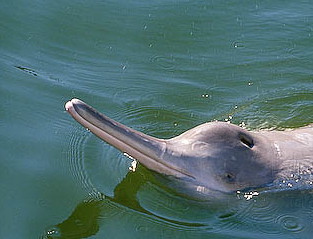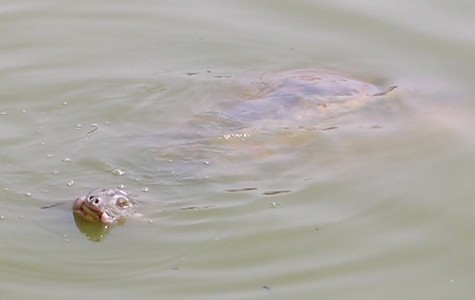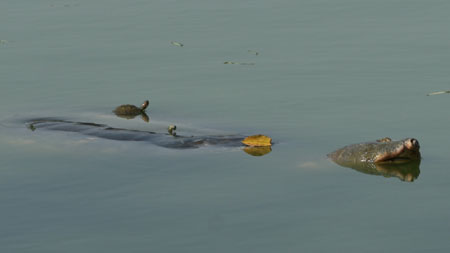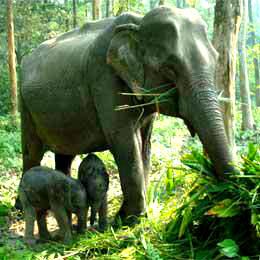The Kashmir Stag (Cervus elaphus hanglu) popularly known as Hangul, is the only surviving subspecies of Red deer in the whole of Asia.
In early 20th century, the Hangul population was believed to be around 5000 spreading across the highland region of Jammu and Kashmir and Himachal pradesh of India. In 1940, a survey revealed the population to be around 3000. The cultivation and hunting was believed to be reason for the population decline for this magnificant deer species at that time. But in the post independence (1947) era of India, the population declined steeply.
A survey published by E. P. Gee in 1957 revealed that only 400 specimens of the Kashmir Stag is surviving in the region. This survey placed the rare deer species as one of the most endangered species of the Indian subcontinent along with Indian Rhino and Asiatic Lion.
In 1967, George B. Schaller , in his study of Kasmir Stag, estimated the population as 180 only. It was based on 88 deer observed in the region. So, despite identified as a rare animal a decade back, the population of this beautiful deer continued to decline.
In 1970, as per Wildlife Journal December issue authored by another naturalist Dr Holloway the population of Kashmiri Stag estimated as mere 140. Holloway also wrote that Hangul’s territory shrunk to an area of 65 kms wide. He said the area seemed to be overgrazed, with erosion becoming apparent due to grazing by thousands of cattle of Gujjars. This created red alarm among the wildlife organizations across the globe. The same year Government of India and Jammu and Kashmir along with IUCN and WWF launched a major conservation project named “Project Hangul”. Both the wildlife organizations along with the government, the project slowly showed results in later years.
The major inputs to the Project Hangul in the earlier stages were research and monitoring. Kahmir Stag’s habitat, terrotoriality, population dynamics and predotors, etc studied very closely. In 1977, there was a report of increase in Hanglu population. But a disease killed over 50 Hanguls in 1978. Dr Fred Kurt, who studied Hangul in Dachigam until 1979 gave some tips to J-K government over protection of Hangul and its habitat. Some intense conservation steps were taken in the Dachigam Sanctuary following these tips. Strict patrolling was started, the poaching of the stag reduced sgnificantly. Deforestation was banned and most of the Gujjars and Bakerwals living near the sanctuary were shifted by the government. The Dachigam was upgraded to National Park status in 1981. Also the project took special care for diseases amonng the haguls, wild fire, etc. All these hard work byt the project team started giving result when in 1980 the population for the Hanguls were reported as around 550. In 1987 it increased to around 800. In September-October 1988, the census conducted by department in collaboration with the Wildlife Institute of Dehradun and Centre for Wildlife and Ornithology, Aligarh had put the population of Hangul in the area as high as 918 animals with 48:52 as male-female ratio. This was a real positive sign for the survival of the species.
But 1988 marks as the end of positive trend for Kasmir stag population. The same year, the political imbalance broke out in the sate Jammu and Kashmir. It was a big blow to the project Hangul and conservation of the Kashmir Stag. The cross border terrorism in the state affected the wildlife too along with many human lives. Militants killed Hanguls for meat and also poaching increased in the park due to loosen security measures. And the Hnguls suffered the most due to all these. There were disturbances in breeding grounds and final verdict was out when a 1996 survey revealed the hungul population to be just 110, the lowest ever recorded in the history!
The cross border terrorism is still an issue int the region, so the kashmir Stags are also continuing the struggle of survival. The census of 2004 estimated the population of Hangul at 197 while in 2008 it reduced to 127. The current a population of Kashmir Stag is estimated just around 220 (survey 2011). This means a slight rise from the last survey done in 2009 when the estimated population was near 170. The 2009 census indicated that for every 100 females, there are 27 males and 28 fawns as compared to 23 and 9 respectively in 2008.
Four decades past now, conservationists finding it difficult to grow the Kashmir Stag’s population from 150 in 1970 till date. It is now identified as critically endangered species in the red list of IUCN.
The Ministry of Environments and Forestry, India has already approved Rs 22 crores Species Recovery Plan for Hangul for a period of five years under the Species Recovery Programme of the “Integrated Development of Wildlife Habitats”. This is a good hope for the rare species. But until the political stability is achieved the Hangul’s are in the mouth of great danger.









Recent Comments